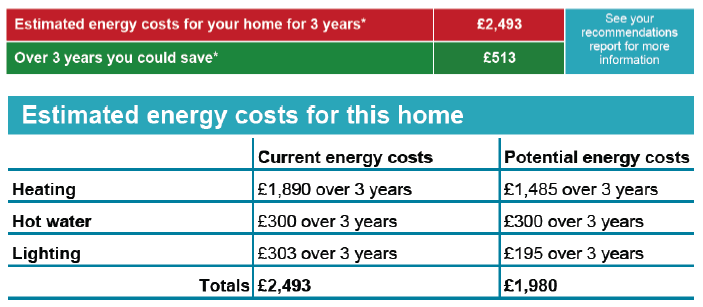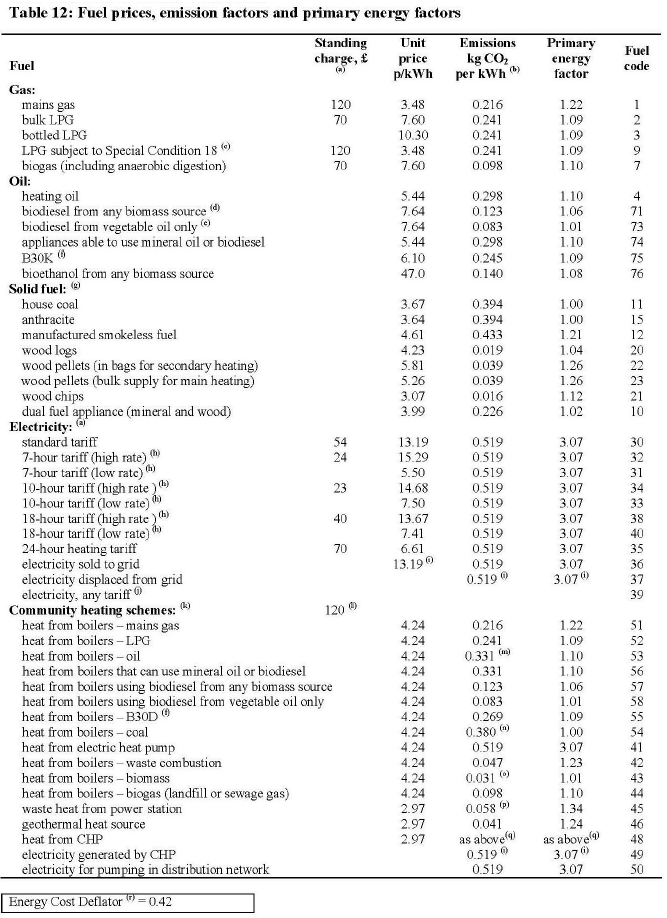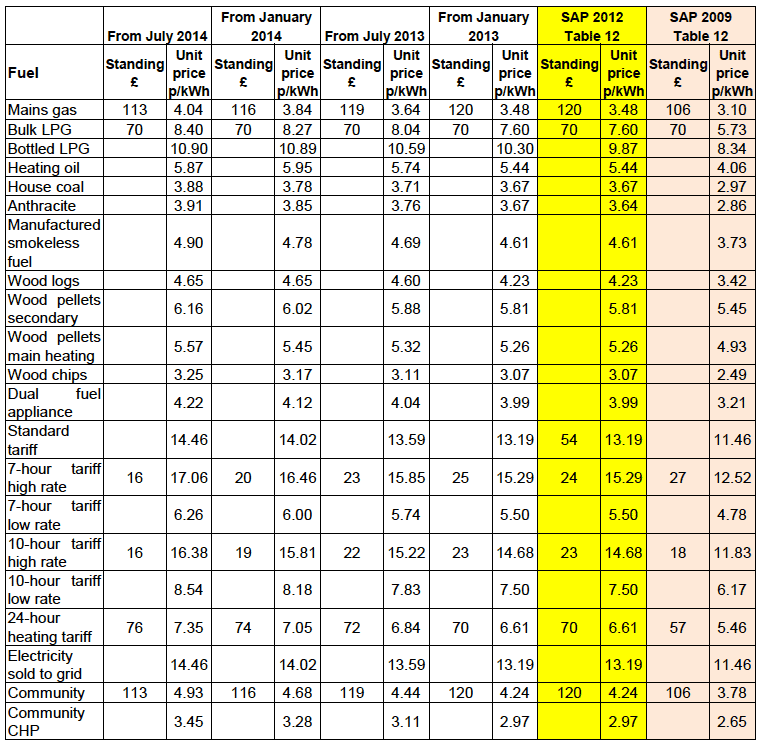Developing regulation of energy efficiency of private sector housing (REEPS): modelling improvements to the target stock - Main Research Report
This report describes how the least energy efficient dwellings in the private sector were identified and how their ratings could be improved by a range of improvement measures. Modelling was used to ascertain the least cost way of reaching different standards, with findings presented on capital costs, fuel cost savings, carbon and energy reductions.
13 Appendix 7: Fuel Costs And SAP And RDSAP
13.1 All of the fuel costs used in the analysis are from the SAP methodology. These are defined in Table 12 of the respective SAP methodology (i.e. SAP 2009, SAP 2012). Table 12 from SAP 2012 is included here as Table A7.1.
13.2 The prices for all of the fuels in SAP and RdSAP are converted to a p/kWh equivalent. Additionally, some (i.e. gas, bulk LPG, biogas, and the various electricity prices) include a standing charge component; some do not.
13.3 These prices in Table 12 are actually 3-year average of the price / standing charge for the respective fuel collated by the BRE from various sources. Costs from different suppliers of different fuels or from different sources are collected and collated annually and then when SAP is revised they calculate the mean price of the preceding 3 years. The BRE use a 3-year rolling average to remove the volatility of the market from calculation. Prices do go down (occasionally).
13.4 SAP calculates the fuel cost for each fuel use in the home (i.e. main space heating, secondary space heating, water heating, lighting, and the running of fans and pumps associated with the ventilation and heating system) by calculating the delivered energy consumption for each of these fuel uses and then multiplying them by the respective fuel unit price in Table 12. SAP then aggregates these costs and adds them to the relevant standing charges to produce the Total Fuel Cost for the dwelling.
13.5 The treatment of the standing charge component within the calculated fuel costs varies depending on the fuel and circumstance. Although Table 12 shows a standing charge for electricity (£54 in Table 12 of SAP 2012), this standing charge is not included in the SAP Total Fuel Costs. The rationale is that everyone is connected to the electricity mains, so everyone has to pay this amount regardless. Where an off-peak electricity tariff is in use, e.g. electric storage heaters, or the householder still has dual rate meters installed although the heating system has been replaced, SAP only adds the 'additional component' of the standing charge for the respective off-peak tariff to the fuel costs. It is this additional standing charge component for the various off-peak electricity tariffs that is set out in Table 12. Where one of the other fuels with a standing charge is used for heating and hot water (e.g. gas or LPG), then that standing charge component is always added to the fuel bill.
13.6 If there was a mains gas cooker in a dwelling that was heated by an otherwise all electric heating system, then there would be no mains gas standing charge added to the SAP Total Fuel Costs. If this all electric heating was a direct acting system on the standard electricity tariff then there would be no additional standing charge applied to the SAP Total Fuel Costs for the dwelling.
13.7 The SAP Total Fuel Costs only comprise the costs associated with space and water heating and lighting in the dwelling. They do NOT include for the costs associated with cooking, appliance use, or (as noted above) the standing charge for standard rate electricity.
13.8 The SAP fuel costs from Table 12 are hard-wired into the SAP programs, and cannot be amended by a user. These costs are not updated annually by BRE. Rather the published versions of the 3-year averages are only amended when a new version of SAP comes out (which is one of the reasons that a revised SAP method is published every few years).
13.9 The result is that the SAP Total Fuel Costs are not the same costs that are paid by a householder. There will be differences in the unit price. The householder will have to pay the full electricity standing charge. The householder will also incur fuel costs for cooking and appliance use (the exclusion of these other costs is an effect of the EU's Energy Performance in Buildings Directive which only set out that member states had to have a methodology that calculated the energy performance of buildings with regard to space and water heating and lighting consumption, and the UK only requiring the SAP methodology to do the minimum to ensure compliance with the EPBD).
13.10 That said, since the introduction of RdSAP 9.91, the software calculates two sets of household fuel costs - one for the calculation of the SAP score (that is, the SAP Total Fuel Costs as set out above), and another that is printed in various places on the EPC that are intended to be more in keeping with what the household is actually paying for fuel for space and water heating and lighting. So, cooking and other appliance costs, as well as the standard rate electricity standing charge are still not included as part of this process.
13.11 To do this, the PCDF now includes two sets of fuel cost tables: those for the calculation of the SAP Total Fuel Costs (to produce the SAP score) and those for the calculation of the household fuel costs (i.e. the 3 year household fuel cost figures that appear on the EPC). They are not the same thing. The basis of the SAP calculation fuel costs are only updated when Table 12 in the respective SAP methodology is amended. The fuel prices used to calculate the household fuel costs on the EPC are updated in the PCDF every six months. See the Table A7.2 over the page for a comparison of the SAP 2009 and SAP 2012 prices versus the household fuel prices for each of the updates since January 2013. Interestingly, the January 2013 household fuel prices are almost identical to the SAP 2012 prices when the SAP 2012 prices are 3-year averages, so you would not expect them to be the same.
13.12 An example of the Energy Costs on the EPC is set out in Figure A7.1 - note they are for 3 years, which is the annual calculated cost multiplied by 3 - there is no inclusion for inflation / changing prices / discounting in this 3 year total, rather, it is a straightforward, simple multiplication of the calculated annual costs at the time the EPC is produced. If you redo the assessment in 6 months' time it is a possibility that these published prices may have changed: the longer the gap between reassessing these prices the more likely they will be different. However, the rating will not change.
13.13 At present the effect of feed-in tariffs has not been factored into SAP. This is under consideration and the UK government will consult on proposals.
Figure A7.1: Energy Costs on the EPC

13.14 Further, there is a difference in the basis of the calculation of the SAP Total Fuel Costs and the Household Fuel Costs. The SAP Total Fuel Costs are calculated for the average UK climate, while the Household Fuel Costs now take account of local climatic variables (i.e. degree day region and height above sea level) - so even if they used the same fuel price for each fuel, the Household Fuel Costs would vary as you move the dwelling around the country while the SAP Total Fuel Costs would not change.
13.15 Neither set of Fuel Cost calculations takes account of actual occupancy. The number of occupants is derived from the floor area of the dwelling.
13.16 Neither set of Fuel Cost calculations take account of different heating patterns. Both assume the dwelling is heated to what is referred to as the Standard Heating Regime, a demand temperature of 21oC in the main living area and 18oC in the rest of the dwelling for 9 hours in 2 periods (2 hours in the morning between 7 and 9AM) during Monday to Friday, and 16 hours in a single period (between 7AM and 11PM) at the weekends.
13.17 Occupant behaviour with regards to actual house temperatures, use of heating, or extent of heating their home, or the appliances actually used are not included in the calculation of either set of fuel costs.
Table A7.1: SAP Table 12: Fuel Prices, emission factors and primary energy factors [87]

Table A7.2: Comparison of Household Fuel Prices in PCDF and SAP 2009 and SAP 2012 Table 12 prices [88]

Contact
Email: Silvia Palombi
There is a problem
Thanks for your feedback